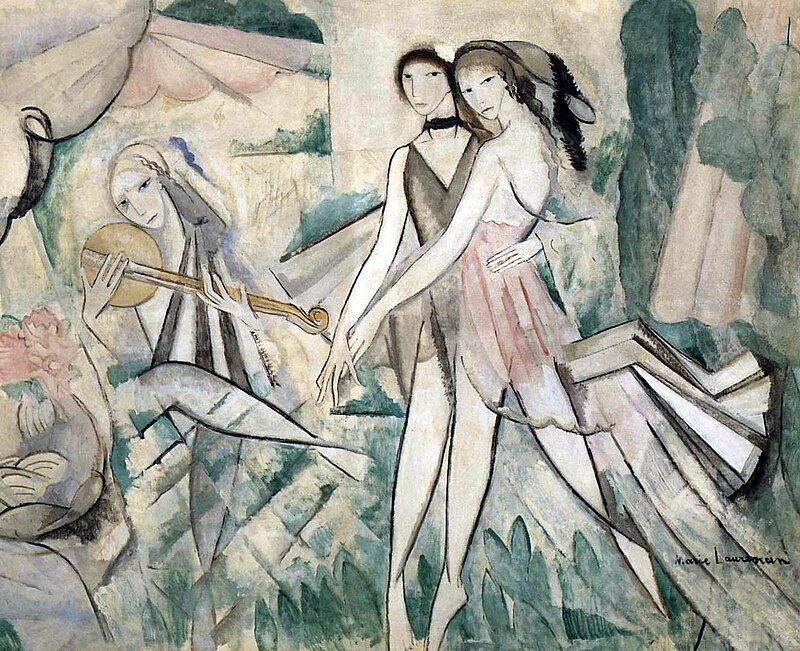Marie Laurencin, a notable figure in the Parisian avant-garde of the early 20th century, carved out a unique niche with her distinctive style and thematic focus. As one of the few women who gained prominence in the art world at the time, Laurencin’s work offers a fascinating blend of soft pastels, delicate figures, and dreamy landscapes that stand apart from the boldness of her contemporaries.
Her paintings, often centered around feminine beauty and camaraderie, exude an ethereal quality that draws viewers into a world of serene elegance and poetic grace. This article aims to shed light on Laurencin’s artistic journey, highlighting how her contributions not only enriched the Cubist movement but also introduced a tender counterpoint to the era’s prevailing artistic narratives.
Who was Marie Laurencin?
Marie Laurencin was a pivotal figure in the art world of early 20th-century Paris, renowned for her distinctive approach to painting that set her apart from her contemporaries. Born in Paris in 1883, Laurencin’s artistic journey began at the École des Beaux-Arts and the Académie Humbert, where she first immersed herself in the world of art. It was during this time that she became associated with influential artists and poets, including Pablo Picasso and Guillaume Apollinaire, which eventually led her to the heart of the avant-garde movement.
Laurencin’s work is celebrated for its unique aesthetic that features soft color palettes, fluid lines, and an ethereal portrayal of women and animals, creating an intimate, dreamlike atmosphere. Unlike the harsher, more abstract forms associated with Cubism, her art exudes a gentle, feminine quality that offers a stark contrast to the dominant trends of her time. Laurencin’s paintings, primarily focused on the themes of femininity and beauty, evoke a sense of tranquility and timeless grace.
Throughout her career, Laurencin navigated the challenges of being a woman in a predominantly male art world, yet she managed to carve out a successful career as an artist, illustrator, and stage designer. Her contributions to art extend beyond her canvases, as she played a significant role in the cultural milieu of Paris, influencing and collaborating with other artists, writers, and musicians.
Marie Laurencin’s legacy is that of an artist who dared to pursue a path less trodden, using her distinct voice to portray the world through a lens of softness and beauty. Her works continue to captivate and inspire, serving as a testament to her innovative spirit and the enduring appeal of her artistic vision.
Famous Paintings of Marie Laurencin
Marie Laurencin’s artistic legacy is marked by her distinctive style, characterized by soft palettes, ethereal figures, and an exploration of femininity. Among her oeuvre, several paintings stand out for their impact and representation of her unique artistic voice. Here’s a look at some of her most famous works:
“The Young Girls” (1911)
In this painting, Laurencin portrays a group of women enshrouded in a dreamlike landscape, embodying themes of camaraderie and femininity that pervade her work. The painting’s soft hues and fluid lines evoke a serene and timeless world, showcasing Laurencin’s mastery of creating spaces that are both ethereal and profoundly connected to the female experience.
“Group of Artists” (1908)
This painting is a seminal work in Laurencin’s career, capturing a convivial gathering of the avant-garde elite, including figures like Picasso and Apollinaire. Its muted tones and the delicate rendering of the figures exemplify Laurencin’s departure from the more rigid forms of Cubism, infusing the composition with a sense of intimacy and poetic grace.
“Portrait of Mademoiselle Chanel” (1923)
In this portrait of the iconic Coco Chanel, Laurencin captures the essence of Chanel’s elegance and modernity. The painting stands out for its subtle use of color and the abstracted background, which focuses attention on Chanel’s figure, highlighting Laurencin’s skill in portraiture and her ability to convey character and style.
“Self-Portrait” (1905)
Laurencin’s self-portrait offers a glimpse into her self-perception and artistic identity at the onset of her career. Characterized by gentle lines and a restrained palette, this work foreshadows the themes and stylistic elements that Laurencin would continue to explore, marking the beginning of a lifelong journey of artistic exploration and expression.
“Apollinaire and His Friends” (1909)
Dedicated to her close friend and poet Guillaume Apollinaire, this work is a testament to the creative synergy within Laurencin’s circle. The painting blends elements of realism and fantasy, placing the figures against a whimsical backdrop that reflects the interconnected world of artists and writers who shaped the Parisian avant-garde.
These paintings highlight the breadth of Marie Laurencin’s talent and the distinctive place she holds in art history. Through her innovative approach to color, composition, and subject matter, Laurencin created a body of work that continues to captivate and inspire, offering a window into the world as seen through her eyes.
Conclusion
Marie Laurencin’s journey through the art world of early 20th-century Paris carved a distinct path that resonates with the essence of femininity, beauty, and an ethereal perspective on life. Her contributions to art go beyond the soft pastel hues and dreamlike figures that define her work; they embody a bold exploration of identity and emotion through a lens uniquely her own. Laurencin’s paintings, celebrated for their gentle defiance against the dominant trends of her time, offer a serene refuge that continues to captivate and inspire.
